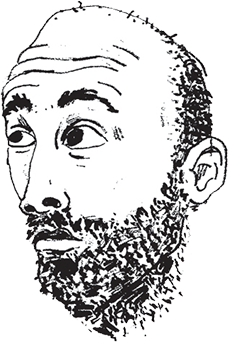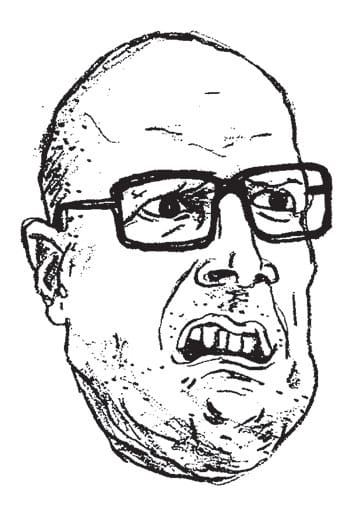You mentioned that you play around with grids in this project. What is it about these grids that fascinates you, and where does the urge to disrupt them come from?
I became more fascinated by grids through the graphic novel I’m currently working on. Comics, of course, often consist of images in frames, separated by gutters. These gutters play an important role in how we perceive time and rhythm within a story. I started experimenting by drawing a space that stretches across multiple frames to see whether the viewer would still interpret the page as a sequence of events or rather as one cohesive image. In these illustrations, I took that a bit further by letting the blobs cross over into other frames. Because of that, the space in between became more of a framework than a mere gutter. The blobs seem to interact with this framework, sometimes trying to escape it, sometimes almost embracing it.
What are important themes in your work and what draws you to them?
I’m often drawn to abstract, human themes and how they manifest in our current society. For example: identity, individualism, societal and cultural norms, and the influence of contemporary developments on these concepts. I’m interested in questions like: Does being constantly connected make us feel more or less lonely? What effect do social media and dating profiles have on our sense of identity? And also: How does the design of a city influence the way we interact with each other? It always comes down to human interaction, either with one another or with their surroundings. In a more abstract way, that’s also present in these illustrations.
Have you always had a passion for illustrating? And what led you to make it your career?
I’ve been drawing for as long as I can remember. It’s funny to realize that, even as a child, I was already creating little ‘scenes’ in my drawings, trying to depict stereotypes, their interactions, and their environments. I have many drawings of disproportionate figures, wildly gesturing at each other while sitting in spaces with no perspective. I distinctly remember being frustrated that my drawing skills weren’t developed enough to properly render the interiors and characters so the scenes would come across clearly. I think I’ve always subconsciously tried to communicate some kind of message or story through drawing, probably just as a way to express myself. I’ve always enjoyed questioning the things we consider ‘normal’ in society and transforming them in ways that make you doubt their normality. I chose to make this my career simply because I know drawing is something I always want to keep doing.
What does your creative process look like?
When an idea comes from my own fascination, there’s usually already an image in my mind, so I immediately start sketching. For commissions, I like to research the subject first so I can give it my own interpretation. I usually make a few tiny sketches on paper using a very soft pencil. These first sketches are very messy; I’m only concerned with the content and composition at this stage. Once I’m happy with a small sketch, I make a larger version, still with pencil on paper. Recently, I’ve started coloring the illustrations with colored pencils instead of finishing them digitally, like I used to. I enjoy returning to a more analog way of working. It helps me lose track of time in a very nice way.
Do you have any ambitions for the future that you can share with us? And when can we expect the graphic novel that you’re working on?
Currently, I’m mainly focused on Verso, the graphic novel, which will be published in 2026. Besides that, I’m working on a shorter, more abstract comic, and I’d like to continue exploring how I can tell visual stories using different materials and forms. For example, I would love to create an illustrative installation at some point. A kind of graphic novel brought to life, literally surrounding the viewer.
Things on Hooks will be opening on May 9th at 17:30 in Werkplaats
www.volkshotel.nl/agenda
Follow Jasmijn on: @jasmijndenood
www.jasmijndenood.com


